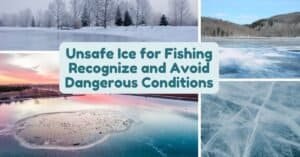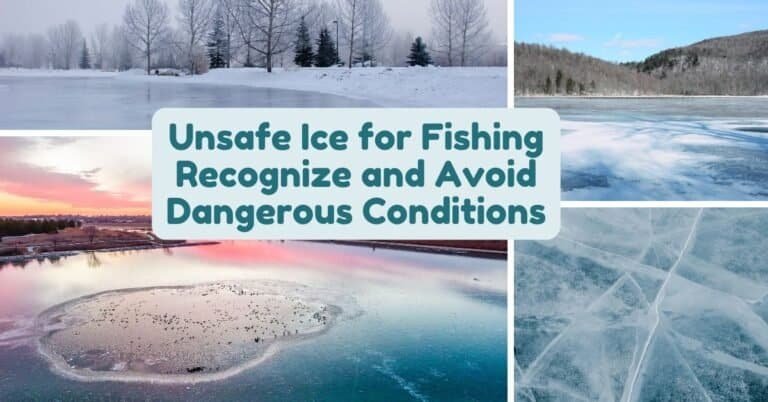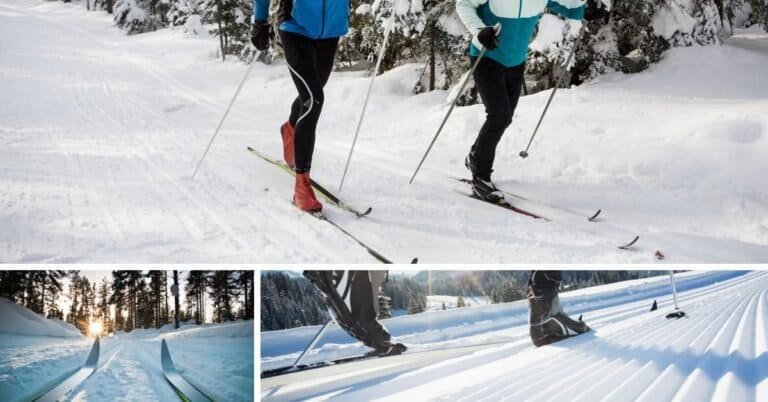Unsafe Ice: Understanding the Hidden Risks of Ice Fishing
Fishing on frozen waters can be exhilarating, but safety should always come first! Did you know that nearly 20% of ice-related accidents occur due to misjudging ice conditions? I’ve been there, facing the daunting crack of unstable ice beneath my feet. In this article, we’ll look into how to identify unsafe ice for fishing, understand the factors that make ice risky, and equip ourselves with the knowledge to enjoy fishing safely. Let’s make your next ice fishing trip safe and memorable!
What Is Unsafe Ice?
Let me tell you, learning about unsafe ice the hard way isn’t something I’d recommend. A few winters ago, I had what I’ll call a “wake-up call” while ice fishing with some friends. We thought the lake was solid, but within a few steps, the ice started cracking. Thankfully, no one got wet, but that experience taught me just how deceptive ice can be. So, let’s look into what makes ice unsafe so you don’t have to learn the hard way.
Definition of Unsafe Ice
Unsafe ice is any frozen surface that lacks the structural integrity to support weight safely. That might sound obvious, but the tricky part is that it’s not always about whether the ice “looks” strong. Factors like temperature fluctuations, water currents beneath the surface, and even the type of water, fresh or salt can affect its stability. Just because it’s been cold for a few days doesn’t mean ice is automatically safe. Ice forms in layers, and those layers can weaken depending on a bunch of sneaky factors we’ll cover in a sec.
Common Characteristics of Weak or Unstable Ice
First things first: cracks and ridges on the surface are red flags. These often signal stress points where the ice is more likely to break. Ice near shorelines, bridges, or docks is usually weaker because the water underneath is constantly moving. And if you see slushy or wet spots on top of the ice? Stay far away. That’s a sign the ice is melting, even if it looks solid from a distance.
Another thing to watch for is newly formed ice that hasn’t had time to thicken properly. Ice needs consistent, freezing temperatures to build strength, and even then, it’s not an overnight process. If you’re venturing out on the ice that formed in the past couple of days, you’re probably taking a huge risk. Oh, and ice with visible bubbles or cracks running through it? Hard pass, it’s unstable and unpredictable.
How Ice Thickness and Color Indicate Safety Levels
Here’s where things get a little technical, but trust me, it’s worth knowing. Ice thickness is the best indicator of whether it’s safe to walk, skate, or drive on. The rule of thumb is 4 inches for walking, 6–8 inches for skating, 8-12 inches for snowmobiles, 12-16 inches for small vehicles, and 16+ inches for trucks. Anything less than 4 inches is off-limits, no matter how tempting it looks.
Color is another big clue. Clear, blue ice is the gold standard—it’s the strongest because it’s formed under consistent, freezing temperatures. White or opaque ice is weaker because it’s often a mix of frozen water and air pockets. And then there’s the dreaded gray ice. If you see gray, back away. It’s a sign the ice is melting and water is mixing in, which makes it extremely unstable.
One last tip: Carry an ice chisel (spud bar) or auger to test the thickness as you go. Trust me, a few extra minutes of caution can save you a lot of trouble and possibly a dip in freezing water.
Now, if you’re like me and love outdoor adventures, respecting these signs can make or break your experience. The more you understand unsafe ice, the safer and more confident you’ll feel out there.
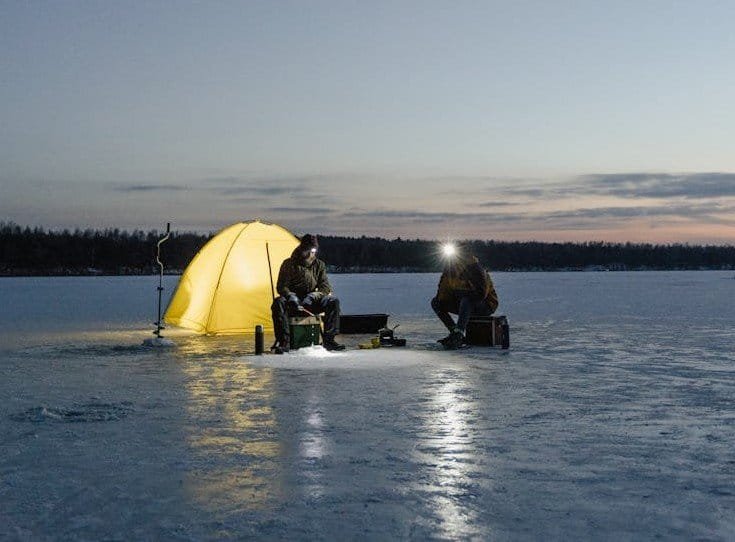
Factors That Contribute to Unsafe Ice Conditions
Ice safety can be tricky, and I’ve learned this firsthand during a few too many nerve-wracking moments on frozen lakes. While the allure of skating or fishing on a pristine, glassy surface is hard to resist, there are some serious factors that can make ice downright dangerous. Let me walk you through the key culprits that contribute to unsafe ice conditions based on both personal mishaps and research I wish I’d done sooner.
Weather Fluctuations: The Freeze-Thaw Rollercoaster
One winter, I made the rookie mistake of assuming that a week of freezing temperatures meant the ice was solid. Spoiler alert: it wasn’t. That year, we’d had a few warm days before the cold snap, which caused a thawing and refreezing cycle. These cycles are brutal for ice stability because they create layers of weak, brittle ice instead of one solid sheet. Even when it looks thick, it might crumble under pressure.
Here’s a tip: If the weather’s been flip-flopping between freezing and thawing, assume the ice is weaker than it seems. Look for clear, blue ice; it’s usually the strongest. Avoid milky, white ice, which is often layered with air pockets and weaker spots. And if the ice is gray, don’t even think about stepping on it, it’s usually on its last legs.
Water Currents and Moving Water Beneath the Ice
This one caught me by surprise during an ice fishing trip. I set up my gear near what seemed like a solid patch, but I didn’t realize there was a hidden current underneath. Moving water prevents ice from freezing evenly, and sometimes, it doesn’t freeze at all. That patch turned out to be thinner than the rest of the lake, and let me tell you, I’ve never backed away from a spot so fast in my life.
If you’re near a river inlet, an outlet, or even underwater springs, be extra cautious. These areas tend to have unpredictable ice thickness, no matter how cold it’s been. Bring an ice auger to test the thickness in multiple spots; it should be at least 4 inches for walking and 8-12 inches for snowmobiles.
Snow Cover: Insulation That Works Against You
Here’s a fun fact most people don’t know: snow acts as an insulator, which slows the freezing process. One time, I ventured onto a snow-covered pond, assuming it was as solid as a nearby cleared rink. Nope. The snow had kept the ice from freezing to a safe thickness, and my boot broke through near the edge.
Always remember, snow can make ice look thicker than it really is. Clear off a small area to see what’s underneath. And while snow-covered ice might seem picturesque, it’s a good idea to tread carefully, especially after a fresh snowfall.
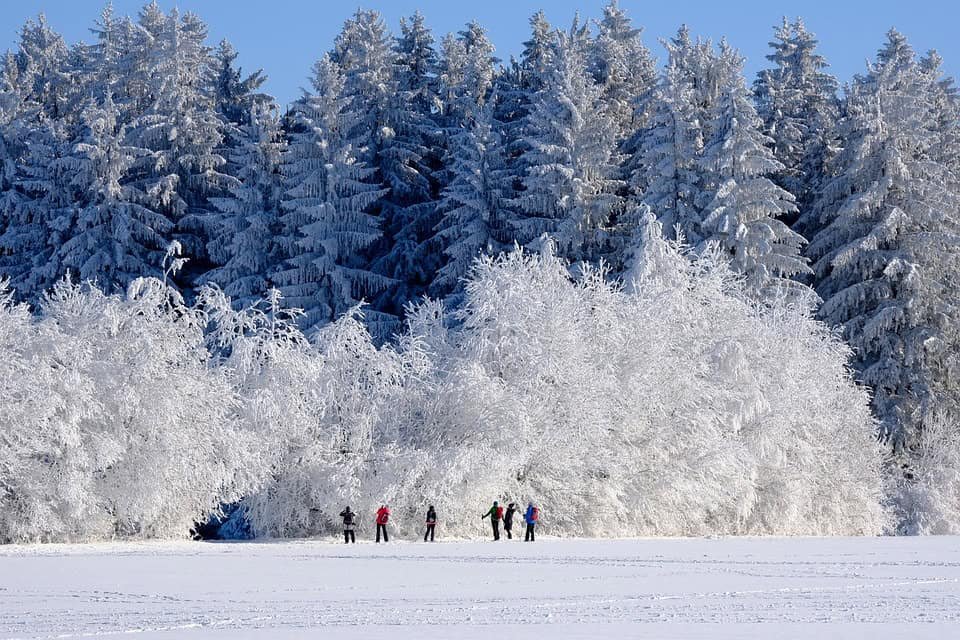
Human Activities: Weakening the Ice
Ice isn’t indestructible, and human activity can take a toll. A couple of years ago, I joined a group of friends for some ice fishing, only to realize that repeated drilling in one area had turned the ice into Swiss cheese. Worse yet, snowmobiles had been zipping across the lake all day, which created stress fractures in the ice.
If you’re out on the ice, spread out your activities. Avoid congregating in one spot, and be mindful of other people’s tracks and holes. Remember, ice doesn’t have a reset button—every hole or crack weakens its structure.
Warning Signs of Unsafe Ice
You know that feeling when you’re about to step onto the ice, and something just feels… off? Yeah, me too. Trusting your gut is important, but learning to read the warning signs of unsafe ice is a game-changer. Over the years, I’ve picked up a few tricks (and had some close calls) that might just save you from a wet and chilly disaster.
Visual Clues: Cracks, Slush, or Wet Areas
The first lesson I learned about unsafe ice? Pay attention to what it looks like. Cracks are the obvious red flag. They’re like Mother Nature’s way of saying, “Stop, go no further!” Even small cracks can indicate thinning or unstable areas, especially if they branch out like spiderwebs.
And don’t even get me started on slush. One time, I thought I could “just step around it.” Bad idea. Slushy patches mean the ice is melting or weakened from below. Trust me, there’s no stepping around slush, just turn back. Similarly, wet spots are a hard pass. These usually form where the ice is thin, allowing water to seep through, often near shorelines or areas with flowing water like streams or springs.
Audible Indicators: Creaks, Groans, and Splashes
Ice talks. No, seriously, it has a whole language. If you hear loud creaks and groans as you walk, that’s the ice telling you it’s under stress. I used to think these sounds were normal, but nope. Healthy ice might pop occasionally, but constant noise means it’s shifting or struggling to support weight.
The scariest sound? A sudden splash nearby. This usually happens when ice in the distance starts breaking apart, sometimes because of temperature changes or pressure shifts. Once, I heard a splash a few feet ahead of me while walking on a frozen lake. Let me tell you, my heart dropped faster than my fishing line. I backed away slowly and safely, but it was a wake-up call to stay alert.
Understanding Ice Color Changes
This one took me a while to figure out, but the color of the ice can tell you a lot about its safety. Clear, blue ice is the strongest. It’s been cold long enough to freeze deeply, and it’s solid. White ice? That’s a mix of snow and ice, and while it can be okay, it’s not as strong as clear blue. Always approach with caution.
Gray ice, though, is a no-go. It’s waterlogged and weak. Think of it like a sponge, it might look solid on the surface, but step on it, and you’ll be taking a very cold bath.
Bonus Tip: Learn to Trust the Locals
If you’re not sure about the ice, ask someone who knows the area. Locals or seasoned anglers are like walking ice encyclopedias. They’ve seen the patterns, know the weak spots, and can give you solid advice on where to avoid.
Bottom line: Stay alert, trust the clues, and don’t take risks. Ice might look like an adventure, but it’s not worth gambling your safety or life over.
Dangers of Fishing on Unsafe Ice
Fishing on ice can be an exhilarating experience but let me tell you; it’s not something you want to take lightly. I learned that the hard way one winter when I underestimated the risks. That day started with excitement, but a loud crack under my feet taught me a lesson I’ll never forget. Fishing on unsafe ice is no joke, and the dangers are far more real than they might seem.
Risk of Hypothermia and Drowning
The most obvious danger is breaking through thin ice, and trust me, you don’t realize how cold water is until you’re in it. Even if you’re a strong swimmer, hypothermia can set in within minutes in freezing temperatures. Once, a buddy of mine stepped onto a patch of ice that looked solid but wasn’t. It was terrifying watching him struggle as the icy water swallowed him up to his chest. Luckily, we had safety ropes, and he managed to pull himself out before things got worse.
The scariest part? Hypothermia doesn’t just mean shivering; it clouds your judgment and makes it harder to think straight. If you’re planning to ice fish, invest in a flotation suit or, at the very least, a life jacket. It’s not overkill; it’s being smart. Always check the thickness of the ice with a spud bar or an auger. Safe ice for walking is at least four inches thick; anything less is a gamble with your life.
Collapsing Ice Shelves and Ice Break-Offs
One of the sneakiest dangers is collapsing ice shelves, especially near the edges of a lake. These areas are more prone to thinning because of fluctuating temperatures or currents beneath the ice. A few years ago, I was fishing on what I thought was a secure spot when a massive crack separated our ice section from the shore. I had no idea how quickly an ice break-off could happen. One minute, you’re on stable ground, and the next, you’re floating on an iceberg.
The key here is paying attention to weather reports and avoiding areas near inlets, outlets, or pressure ridges where ice tends to weaken. If you’re fishing in a group, spread out your weight instead of clustering together. It reduces the risk of a total collapse if the ice gives way.
Equipment and Vehicle Hazards
I’ve seen people drive trucks onto the ice, thinking it’s safe because it looks solid, big mistake. Ice may seem thick, but even eight inches can’t always hold a vehicle’s weight, especially if the ice has inconsistencies. I’ll never forget watching a snowmobile disappear into a slushy grave because someone underestimated the ice’s strength.
It’s not just vehicles, though. Even dragging heavy equipment like ice shanties or heavy sleds across thin ice can cause it to buckle. Use lightweight gear whenever possible, and if you absolutely need to haul heavier items, distribute the load across sleds or platforms. Having ice claws or picks on hand can be a lifesaver if you do end up falling through.
Fishing on ice is thrilling, but it’s no place for shortcuts or overconfidence. Respect the risks, prepare like your life depends on it (because it does), and always err on the side of caution. It’s better to head home without a catch than to not make it home at all.
How to Test Ice Safety
Testing ice safety is one of those things where you can’t afford to “wing it.” Trust me, I learned this the hard way during a poorly planned fishing trip years ago. Standing on cracking ice isn’t the kind of thrill anyone wants. Let’s break it down into tools, recommendations, and a solid step-by-step process that’ll keep you safe.
Tools for Testing Ice Thickness
The right tools make all the difference. Personally, I always carry an ice auger, a spud bar, and a good old-fashioned tape measure when heading out. Each tool has a role. An ice auger is excellent for drilling clean holes to measure the thickness, but if you’re just scouting, a spud bar is faster. The spud bar is essentially a long, heavy chisel, and you use it to strike the ice in front of you as you walk. If it punches through with one or two hits, the ice is too thin. Simple, right?
A tape measure is your final check. Don’t rely on guessing; eyeballing ice thickness can be deceptive. Insert it into the hole you drilled and measure from the bottom of the ice to the surface. It’s a straightforward tool, but it’s saved my hide plenty of times.

Recommended Thickness Levels
Here’s the golden rule: know the thickness guidelines before you even step out. For walking, you’ll need at least 4 inches of solid, clear ice. That’s not the cloudy, brittle stuff either – it needs to look like a clear pane of glass.
Ice fishing requires a bit more stability, so aim for 6-7 inches. If you’re driving an ATV or snowmobile, you’ll need at least 8-12 inches. Vehicles like cars or small trucks? Don’t even think about it until there’s a minimum of 12-15 inches, and even then, proceed with extreme caution. I personally never drive on the ice with a car or truck because if you go through. The recovery cost and environmental fees are astronomical, and insurance won’t cover you.
One time, I thought 5 inches of ice would be fine for fishing with a sled. Big mistake. The ice held, but the cracking sounds were enough to ruin my day. Lesson learned: better safe than sorry.
An Ice Thickness Safety Chart is available in our downloads page.
Step-by-Step Guide to Testing Ice Safely
Start near the shore. The ice is usually thicker there, but still, test it. Use your spud bar or auger to check the thickness before venturing farther out.
Test every few feet. Don’t assume consistent thickness – ice can be deceiving, especially near currents or where snow covers the surface. Strike the ice with a spud bar or drill a hole and measure with a tape measure.
Look for visual clues. Clear, blue ice is the strongest. Cloudy or white ice is weaker, and ice near reeds, inlets, or moving water is notoriously unsafe. If you see cracks, slush, or pooled water on top, stay back.
Work in pairs. Always bring a buddy and carry safety gear like ice picks and a rope or throw bag. If one of you gets in trouble, the other can help – but only from a safe distance.
Don’t rush. If you’re testing with a spud bar and it punches through in just one strike, backtrack immediately. Thin ice can spread danger faster than you think.
Bonus Tip
A personal floatation device might feel excessive, but it’s a lifesaver – literally. I started wearing one after an experienced angler recommended it, and it’s given me peace of mind. I have since bought an insulated ice fishing suit with built-in flotation. Pair it with ice cleats for extra grip, especially on slippery patches.
In the end, testing ice safety is all about preparation and patience. Those extra minutes you spend checking the ice can save your gear, your day, and even your life.
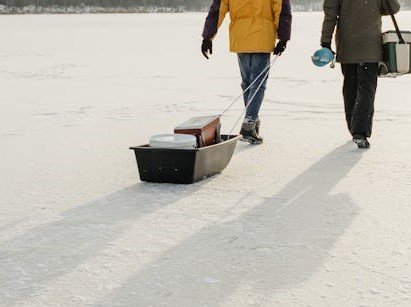
Essential Safety Measures for Ice Fishing
When I first got into ice fishing, I was so pumped about the idea of catching fish in the dead of winter that I overlooked the whole “safety” side of it. Let’s just say it didn’t take long for a wake-up call. Ice fishing is an incredible experience, but it’s also risky if you don’t plan ahead. So, here’s what I’ve learned (sometimes the hard way) about staying safe on the ice.
Must-Have Safety Gear: Life Jackets, Ice Picks, and Rescue Ropes
Okay, let’s start with the essentials. If you’re heading out onto frozen water, you absolutely need a life jacket or floatation suit. Yes, I know, it feels weird to put on a life jacket in the middle of winter when you’re surrounded by solid ice. But here’s the thing: ice isn’t always as solid as it looks. A life jacket could literally save your life if you end up in freezing water.
Ice picks are another non-negotiable. If you’ve never used them, they’re basically sharp tools you can stab into the ice to pull yourself out if you fall through. I keep mine on a lanyard around my neck, so they’re easy to grab if I need them. And trust me, you don’t want to be fumbling through your gear while soaking wet and freezing.
Then there’s the rescue rope. This one saved my buddy once when he accidentally stepped on a weak spot. It’s a simple thing, a strong, floating rope with a loop on one end but it’s a lifesaver. Keep it coiled and ready to toss because seconds count in an emergency.
The Buddy System: Why You Should Never Fish Alone
Now, let’s talk about one of the cardinal rules: don’t fish alone. I get it, sometimes you just want some peace and quiet out on the ice. But the buddy system isn’t just about company; it’s about survival.
A few winters ago, I decided to go solo because none of my friends could make it. Big mistake. I misjudged the thickness of the ice, and before I knew it, I was ankle-deep in icy water. I managed to crawl back to safety, but if I’d gone through completely, who knows what would’ve happened? Having someone there to call for help or throw a rescue rope can make all the difference.
Emergency Action Plan If the Ice Breaks
So, what if the worst happens and you go through the ice? First, don’t panic. Easier said than done, I know. Your first instinct will be to flail around, but that’ll just waste energy and make things worse.
Here’s what to do: turn toward the direction you came from because the ice was solid enough to hold you there before. Use your ice picks (this is why they’re crucial!) to dig into the ice and pull yourself up. Kick your legs to help push yourself onto the surface. Once you’re out, don’t stand up right away; roll or crawl to distribute your weight until you’re back on solid ground.
After that, get warm immediately. Hypothermia sets in fast. Have a dry change of clothes in your car or an emergency kit, and don’t hesitate to call for medical help if you feel disoriented or sluggish.
How to Recover After Falling Through Ice
Let me tell you, falling through the ice is something you never think will happen to you until it does. I learned this the hard way a few years back on a frozen lake that wasn’t quite as solid as I thought. It started with a loud, sharp crack beneath my feet, and before I knew it, I was in the water, fighting against the numbing cold. Here’s what I learned from that experience, both from my mistakes and what saved me.
Immediate Steps to Take After Falling Through Ice
First things first: don’t panic. Yeah, easier said than done, right? The moment you hit that icy water, it’s like your brain goes into overdrive, and your body wants to thrash around. But trust me, staying calm is crucial. Take a second to catch your breath. That initial shock can trigger a “cold water gasp,” and if you’re inhaling wildly, you risk swallowing water. Focus on exhaling slowly, it helps you regain some control.
Next, try to keep your head above water and orient yourself. Look for the way you came because that’s your way out. Don’t waste time trying to tread water or swim. Just get yourself out of the water.
Techniques for Self-Rescue
Now, here’s where things get tricky but manageable if you know the right moves. Spread your arms wide over the ice to distribute your weight, like making yourself into a human starfish. If you have a backpack or heavy gear on, ditch it, it’ll only weigh you down.
Once you’ve got your arms steady, start kicking your legs behind you like you’re swimming freestyle. This helps propel your body horizontally, making it easier to slide onto the ice. I remember my boots feeling like they weighed a ton, but the kicking motion kept me from sinking.
When you manage to get your torso onto the ice, don’t stand up right away, that’s a rookie mistake I almost made. Instead, roll away from the hole to spread your weight over a larger area. Crawling on your stomach or rolling keeps the ice from cracking again. If you have ice picks or even car keys handy (which I didn’t at the time, but you bet I carry them now), they can help you grip the ice and pull yourself out faster.
The Importance of Warming Up and Seeking Medical Attention
Once you’re out, the job isn’t done. Hypothermia sets in fast, even if you think you’re fine. Your wet clothes will steal heat from your body quicker than you realize, so strip off anything soaked and get into dry layers immediately. If there’s no shelter nearby, use anything you have to insulate yourself, blankets, spare clothes, even sitting on a backpack instead of the ground helps.
I didn’t fully appreciate how sneaky hypothermia is until I started shivering uncontrollably after I thought I was safe. Your body might feel numb and sluggish, but getting to warmth is non-negotiable. If you’re near a car, crank the heat. If you’re with others, don’t be shy about asking for help; they can bundle you up or even share body heat.
Finally, go see a doctor. Falling into freezing water can do a number on your system, and you might not even notice signs of frostbite or deeper issues like respiratory problems right away. That day, I was stubborn and thought, “I’ll warm up and be fine,” but in hindsight, a quick medical check would’ve been smart.
Common Myths About Ice Safety
**Debunking Myths Like “Thick Ice is Always Safe”
Ah, the old “thicker is safer” myth; one of the biggest misconceptions when it comes to ice safety. I’ve fallen for this one, figuratively and almost literally, more times than I care to admit. Just because the ice looks thick doesn’t mean it’s structurally sound. I learned this the hard way during an early-season ice fishing trip when I assumed a foot-thick patch of ice was a green light. Turns out, the ice had formed unevenly, and a section near shore had a sneaky current underneath. Let’s just say I got way closer to the water than I’d planned.
What I’ve realized (after some research and a close call) is that ice can have varying thicknesses depending on what’s happening below the surface, currents, springs, and even plant life can weaken certain areas. Just because someone measured the ice as “12 inches” doesn’t mean that thickness is consistent across the entire surface. If you’re venturing out, carry a spud bar and test as you go. Never trust thickness alone; ice conditions are as fickle as Midwest weather in March.
Why Clear Ice Isn’t Always Better Than White Ice
If you’ve ever heard someone rave about “clear ice” being the gold standard, they’re not entirely wrong, but it’s not the whole story. Clear ice, or black ice as some call it, forms under calm and cold conditions, making it denser and stronger than cloudy, white ice. Sounds great, right? Well, here’s the catch: clear ice can be deceiving. It’s hard to spot weak points or cracks, and it’s notoriously slippery not the best combo when you’re hauling gear or, worse, driving a snowmobile.
On the flip side, white ice, which forms after snow melts and refreezes, often gets a bad rap for being weaker. While it’s generally true that white ice isn’t as strong as clear ice, a thick layer of white ice can still be perfectly safe. The trick is in knowing how to measure and evaluate it. My rule of thumb? When in doubt, drill it out. A quick core sample can tell you everything you need to know about the ice’s integrity.
The Truth About Vehicles on Frozen Lakes
Okay, here’s a topic that stirs up all kinds of debates: taking vehicles onto frozen lakes. I’ve seen people drive trucks onto ice that I wouldn’t even trust to hold a bicycle, and honestly, it makes my palms sweat just thinking about it. The truth is, no ice is ever 100% safe for vehicles, no matter how thick it looks. Most safety guides suggest a minimum of 12-15 inches for small cars and 16+ inches for trucks, but even then, it depends on the type of ice and what lies underneath.
Once, I watched a neighbor park their ATV on a frozen lake while we were out ice fishing, only to have it slowly sink into a slushy pocket by the end of the day. Turns out, the ice had been weakened by an underwater spring, something no one noticed until it was too late. The takeaway? If you’re considering taking a vehicle out, stick to well-traveled paths or trails marked as safe. And even then, always have an emergency plan; a tow strap and a buddy go a long way when things go south.
Final Thought
Ice safety myths are dangerous because they give us a false sense of security. The best approach is to question everything, stay prepared, and err on the side of caution. A little skepticism can keep you (and your gear) above water.
Tips for Safe Ice Fishing
Ice fishing is one of those activities that combines patience, skill, and a touch of adventure. But if you’re like me, the first time you step onto a frozen lake can feel downright nerve-wracking. I’ve learned through trial and error (and a few close calls) that preparation is everything. Here are some tips that can make your ice fishing experience safer and way more enjoyable.
Planning Your Trip Around Weather Forecasts
I can’t stress this enough: the weather isn’t just a side note in ice fishing; it’s the headliner. I’ll never forget the time I planned a trip without checking the forecast closely. A sudden warm front moved in, and what was supposed to be a relaxing day turned into me nervously testing every step back to shore. Now, I always check not just the day’s forecast but the trends from the past week.
Cold, stable weather is ideal, as it helps ice thicken and stay consistent. Avoid days when temperatures are fluctuating or if rain is predicted; it’s just not worth the risk. Apps like AccuWeather or your local meteorological site are lifesavers for this. And while you’re at it, look for wind conditions too. Strong winds on an open lake can make even the thickest ice feel unsteady.
Checking Ice Conditions With Local Resources
Here’s where I’ve really learned to lean on the pros. I used to think I could eyeball the ice and just “figure it out.” Bad idea. One time, a local bait shop owner clued me in that a nearby lake had thinner ice in one area because of an underwater spring, a detail you’d never guess by looking at the surface.
Always check with local bait shops, park services, or fishing groups before heading out. They’ll have up-to-date info on ice thickness and any sketchy spots to avoid. As a rule of thumb, aim for at least 4 inches of clear, solid ice for walking, 8-12 inches for snowmobiles, and a good 12–16 inches if you’re hauling a vehicle or heavier gear. And while we’re here, avoid cloudy or slushy ice altogether; it’s just not stable enough.
Creating a Checklist for a Safe and Enjoyable Trip
If you’re anything like me, packing for ice fishing feels like juggling a dozen things at once. Forgetting even one key item, like a hand auger can throw off your entire day. Now, I swear by my checklist. It not only keeps me organized but also ensures I’ve got everything for safety and fun.
Here’s a quick rundown of what’s always on my list:
Safety Gear: Ice cleats, a spud bar, and ice picks (these have saved lives so don’t skip them).
Clothing: Waterproof boots, thermal socks, and layers. Trust me, there’s no such thing as “too warm” on the ice.
Fishing Equipment: Rods, bait, an auger, and a slotted spoon to clear ice chips.
Navigation and Communication: A GPS device, a map of the lake, and a fully charged phone or radio.
Emergency Kit: A whistle, first aid kit, rope, and fire-starting supplies. I even throw in a few energy bars because getting hungry on the ice isn’t fun.
Checking these items off before you leave means you’re less likely to panic if something goes wrong. And trust me, you’ll fish better when you’re not worrying about what you forgot at home.
Stay Safe and Smart: The Key to Enjoyable Ice Fishing Adventures
Fishing on frozen waters doesn’t have to be risky, knowledge is your greatest tool! By understanding the signs of unsafe ice, using the right tools to test conditions, and following essential safety tips, you can confidently enjoy your ice fishing adventures. Stay safe, stay prepared, and make unforgettable memories out there. Share this guide with your fishing buddies to spread awareness and ensure everyone returns home safely!
FAQ Section
How thick should ice be before fishing on it?
Ice should be at least 4 inches thick for walking, 6-8 inches for a group, 8-12 inches for snowmobiles or ATVs, and 12-16+ inches for small cars or trucks. Always test the ice thickness in multiple spots before venturing out.
What is the best way to test ice safety?
Use tools like a spud bar, ice auger, or a tape measure to check the thickness of the ice. Test near the shore and gradually as you move deeper. Avoid relying on visual cues alone.
Are certain colors of ice more dangerous?
Yes, ice color can indicate its safety. Clear or blue ice is usually the strongest, while gray, white, or slushy ice often signifies weakened or unsafe conditions.
What should I do if I fall through the ice?
Stay calm, avoid panicking, and try to keep your head above water. Use ice picks to pull yourself back onto solid ice, then roll away from the weak spot before standing. Seek medical attention immediately to prevent hypothermia.
Can snow on ice make it unsafe?
Yes, snow can insulate the ice, preventing it from freezing solidly and hiding weak spots or cracks. Always test ice conditions thoroughly, even if snow appears to cover it evenly.
Disclaimer: This blog post contains affiliate links

